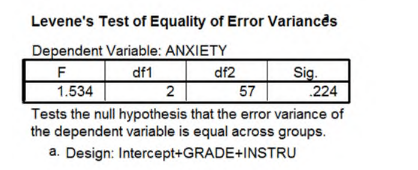Multiple Choice
A music teacher had noticed that some students went to pieces during exams. He wanted to test whether this performance anxiety was different for people playing different instruments. He took groups of guitarists, drummers and pianists (variable = 'Instru') and measured their anxiety (variable = 'Anxiety') during the exam. He also noted the type of exam they were performing (in the UK, musical instrument exams are known as 'grades' and range from 1 to 8) . He wanted to see whether the type of instrument played affected performance anxiety when controlling for the grade of the exam. The first part of the SPSS output is below. What does this part of the output tell us? 
A) The type of instrument played did not have a significant effect on anxiety.
B) The grade of exam taken did not have a significant effect on anxiety.
C) The variances of anxiety scores were roughly the same in the different groups of musicians.
D) The variances of anxiety scores were different in the different groups of musicians.
Correct Answer:

Verified
Correct Answer:
Verified
Q2: A music teacher had noticed that some
Q7: What makes ANCOVA different from ANOVA?<br>A) ANCOVA
Q9: What is not true of the ANCOVA
Q10: A music teacher had noticed that some
Q10: What assumption does ANCOVA have that ANOVA
Q13: Consider the graph below. This is the
Q13: In an ANCOVA with one covariate and
Q16: The following scatterplot represents the results of
Q17: What does ANCOVA allow the researcher to
Q20: What does the effect size measure in